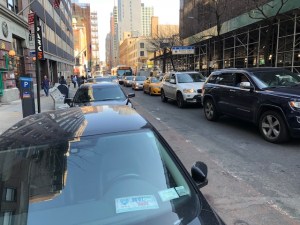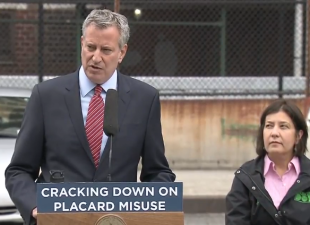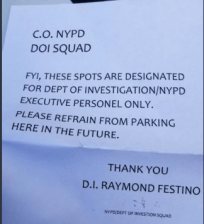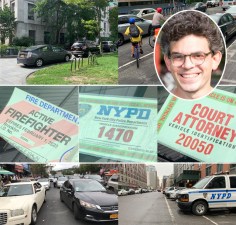NYPD to Council: Leave Our Parking Placards Alone!
Police officials returned to the city council transportation committee with the same tired talking points.
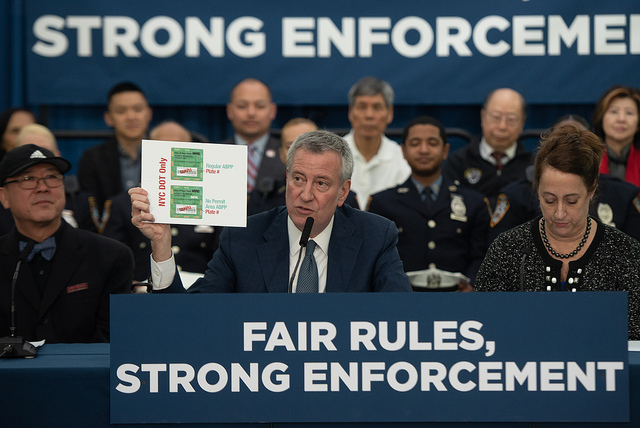
Police officials on Wednesday offered a simple response to City Council Speaker Corey Johnson’s five-pronged legislative approach to curbing rampant parking placard abuse by city employees: no, no, no, no — and, uh, also: no.
And Johnson, for his part, blasted the NYPD for doing “nothing.”
Testifying before the city council transportation committee, NYPD Executive Director of Legislative Affairs Oleg Chernyavsky refused to endorse a single proposal in Johnson’s five-bill package to curb placard abuse — going so far as to diminish the extent of the well-documented problem.
“We acknowledge that placard misuse by city personnel, including our personnel, at times has occurred,” Chernyavsky said, pointing to Mayor de Blasio’s Feb. 21 creation of an electronic placard system, a dedicated placard tow unit, and a three-strike rule against placard abusers as evidence that the police department “takes this issue seriously.”
The council’s bills, however, would go further than de Blasio’s strategy by mandating specific enforcement steps from the NYPD. On that, Chernyavsky was crystal clear: Try again.
Intro. 1393, mandating the NYPD to conduct enforcement blitzes at 50 targeted areas with high numbers of placard abuse complaints, “would require the dedication of significant resources,” Chernyavsky said, also criticizing Intro. 1412, which would authorize private towing companies to remove placard-abusing vehicles. Intro. 1395, requiring NYPD respond to 311 complaints about placard abuse within two days, “poses significant challenges given the extremely short timeline.” Intro. 1422, which would hand over placard distribution to DOT, would create “unacceptable security risks.”
And Intro. 1394 — explicitly prohibiting city vehicles from parking in illegal spots like bus lanes, bike lanes, sidewalks, and fire hydrants except in the case of “documented emergencies” — must be expanded to allow officials to park in those areas during “legitimate law enforcement operations,” he added.
“The answer to placard misuse is one of enforcement and discipline, which continues to be done in significantly increased numbers,” Chernyavsky concluded, though statistics show only a six-percent increase in overall parking summonses issued last year from the previous year.
Other enforcement — such as the creation of an NYPD unit dedicated to parking placard abuse — has also yielded negligible results, and government employees continue to abuse their placard privileges all across the city. There are currently around 150,000 placards in circulation, which effectively allow placard-holders to park wherever they want, whenever they want.

No one — not Mayor de Blasio, not the NYPD, not city DOT — has indicated any plans to reduce the number of placards, which Chernyavsky said are “central” to law enforcement activities because they allow officers “to not spend valuable time … circling streets … in search of an unrestricted parking spot.”
In response, Johnson noted the apparent ineffectiveness of NYPD’s enforcement efforts up until this point.
“There’s never any ticket, Oleg. Nothing is done. There have been complaints for years — and nothing is done,” he said, referring to a specific placard abuse hotspot near City Hall. “It doesn’t seem that the enforcement that you’re doing, and what you all have proposed to do, is going to make much more of a difference.”
The NYPD’s Wednesday afternoon testimony was a near carbon-copy of testimony Chernyavsky gave to the city council last June, in response to a different set of council bills aimed to curb placard abuse.
In prepared remarks, advocates blasted the slow pace of progress towards address the scourge of placard abuse, which has been decades in the making.
“It’s sad that we have to have this hearing and consider bills like the ones before you today,” Bike New York Advocacy Director Jon Orcutt said. “It is already illegal for anyone to park or stop a car in a bike lane.”
